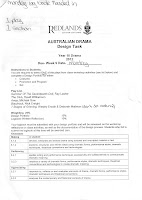We walked straight in and handed our
logbooks in for miss Jansons to mark. I thought I did quite well because I had
done all the lessons and also extra research on each lesson. We got my our
marks back at the end of the lesson and I got 4.5 out of 5 which I think is
quite good but not sure what everyone else got.
The next activity we did was to choose our
groups and do either scene one or scene 2 from the ‘away’ script. We choose to
do the second scene with all the campers, in my group we had Jordan (the
director and also camper 1), molly (camper 2), phoebe (camper 4), reece (Jim), james (Meg) and I was camper 4.
We practiced this scene and we could all tell that with each practice we
were getting better and better, which was good and I hope we have some time
next lesson to practice it as we just need to sort out staging and just
reassuring ourselves about the script.
The focus of the lesson was to get our
logbooks handed in as I think they were 10 percent of our final year mark so it
could really help if mine was good.
As we were meant to read the ‘away’ script
for homework it was just reassuring us about what happens as we can do this
play as one of our assessment plays, I liked this play and I thought the
campers costume could be quite easy because they could be in fisher mans
clothes or may beachy clothes but I want to see the other plays before I start
planning this one.
I thought we did well in our ‘away’ scene
because Jordan is a very good director so she got us all to concentrate which
is quite had when me and molly are in a group together but it was good and she
organized us very well, we it was good she was in our group.
I really liked my group and they were all
fun to work with.
At first it was quite hard because ewe had
2 scripts between 6 of us, so it was hard to read and come in at our right part
but as we practiced we kind of knew when to come in and speak which was good.
Also I think we need to make more hand jesters when we speak to make it more
interesting and also I liked how we added our own bit at the beginning when we
sing merry Christmas which will make ours more interesting then all the other
groups hopefully.
As we didn’t watch anyone’s performances I
cant give any constructive criticism but hopefully we can watch each other next
lesson.
Today we were also handed out our permission forms for trips which i can't wait for.
Today we were also handed out our permission forms for trips which i can't wait for.
research
 |
| Michael Gow |

















